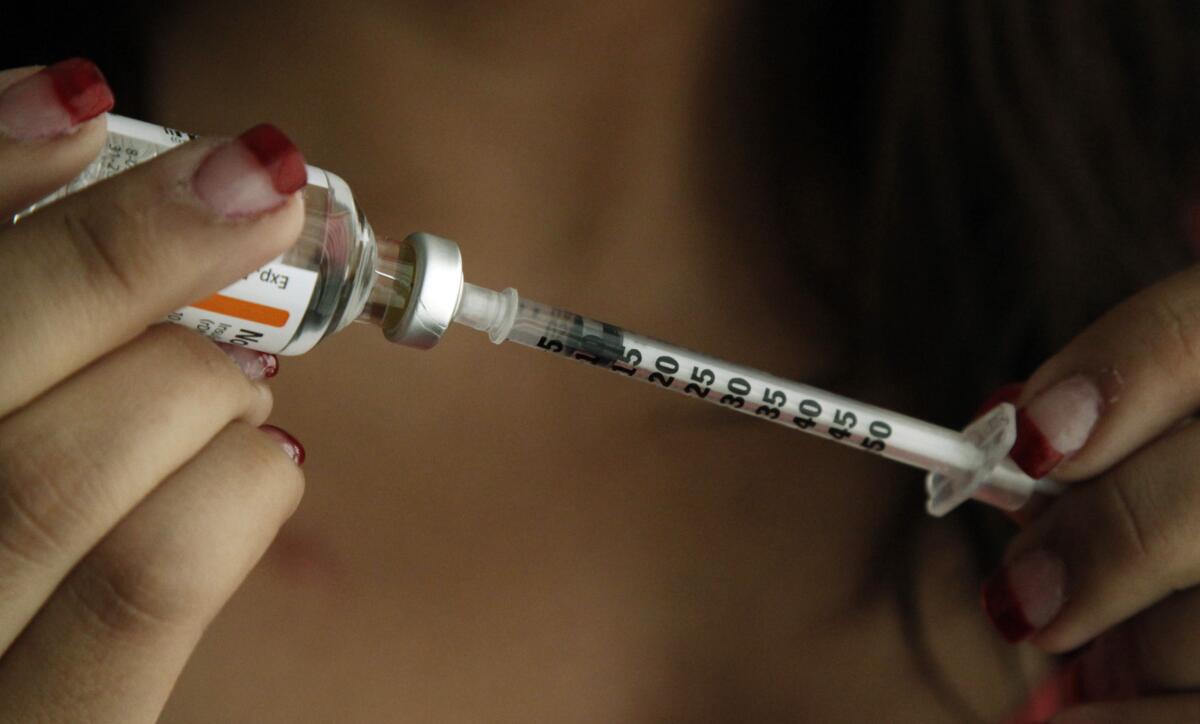Op-Ed: Like many diabetics, I’ve had to ration my insulin. It doesn’t have to be this way

- Share via
“Are you pregnant or hung over?” a colleague once asked as I exited the bathroom stall at work. After going three days without long-acting insulin to treat my Type 1 diabetes, I had been throwing up in the middle of my shift. But I had to get back to work, so I could earn enough tips to buy more. “No, this just happens sometimes,” I answered, downplaying how sick I really was.
It was 2018, I was uninsured — and rationing my insulin because I couldn’t afford it. Being nauseated was a sign of diabetic ketoacidosis, a painful and serious condition that can lead to a diabetic coma or even death.
As a host at a restaurant in Seattle, I was earning too much to qualify for Washington state’s Medicaid program but not nearly enough to buy private insurance. Without it, the medication I need to survive costs roughly $300 a vial, and I am prescribed two every month.
Like me, at least 1 in 4 insulin-dependent diabetics in the U.S. have rationed insulin because of its cost. It doesn’t have to be this way.
President Biden’s $3.5-trillion “Build Back Better” social safety net bill calls for reforms that could make the price of insulin fall by hundreds of dollars, on average. The bill provides Democrats with an opportunity to propose a cap on all out-of-pocket insulin costs and halt the terrifying trend of insulin rationing.
Instead, three Democrats in the House have blocked a provision in the bill that would reform our unjust and out-of-control drug pricing system. Their proposed alternative, which includes a $50 monthly out-of-pocket cap on insulin costs for Medicare beneficiaries, does nothing for underinsured and uninsured diabetics.
As Congress considers its budget reconciliation package, Democrats need to come together to help the roughly 8 million diabetic adults who use one or more forms of insulin to regulate their blood sugar. Without it, the insulin-dependent can experience serious and life-threatening complications.
Nearly 27 million people in the U.S. have been diagnosed with diabetes. It is the seventh-leading cause of death in the United States and the leading cause of kidney failure, adult-onset blindness and lower limb amputations. Every four minutes, a diabetic in the U.S. loses a limb due to diabetes, with Black Americans undergoing twice as many amputations as their white counterparts.
Last week I had surgery for an advanced form of diabetic retinopathy and a partially detached retina, complications of my blood sugar being too high for too long — because I skipped doses while having trouble paying for insulin.
Monthly costs for the most commonly prescribed forms of insulin, a life-sustaining hormone, can easily add up to $1,000 or more for those with high-deductible plans or without insurance.
Year after year, the price of insulin has soared, even though meaningful changes have not been made to their formulas, and they cost only a few dollars per vial to produce. In 1996, Eli Lilly’s Humalog insulin entered the market with a list price of $21 per vial. Today that vial costs almost $275.
I’ve witnessed the impact of this affordability crisis on others through my work with Mutual Aid Diabetes, a group that helps people navigate the complex process of obtaining diabetes medications and supplies.
Instead of significantly reducing prices for their most prescribed insulin products, manufacturers tout discount programs that sometimes provide free medication. But these programs’ eligibility requirements are restrictive, the applications burdensome and the review process lengthy.
For those with urgent diabetes needs, patient assistance programs are of little help. Since March, nearly a third of Mutual Aid Diabetes’ insulin requests required direct financial aid or were filled through referrals to people who share prescribed medication they don’t need.
Over the years, diabetic activists have fought for a patchwork of mostly state-level, imperfect and incomplete solutions to the insulin affordability crisis. It often feels like we’re trying to put out a forest fire of suffering with small cups of water.
Nineteen states have enacted legislation that sets a maximum monthly copay for people who have state-regulated insurance, but these laws don’t apply to an estimated 73% of insulin dependents. Emergency insulin refill measures, such as Minnesota’s Alec’s Law — named for a 26-year-old who died rationing his insulin — have saved lives, but the pharmaceutical industry continues to challenge the law in court. California and Washington have legalized state production of generic insulin, but that is years away.
The pandemic has made the need to act only more urgent. COVID-19 is three times deadlier for diabetics and can trigger insulin resistance, requiring larger doses of insulin to control blood sugar. A recent national survey found that the rate of pandemic homelessness among those with diabetes is 48 times the national average, hitting diabetics of color especially hard.
Half-measures won’t solve this crisis.
At Mutual Aid Diabetes, we often hear from people who can’t come up with the $35 that would allow them to purchase insulin with a manufacturer’s coupon we help them obtain. Like me, they may ration their insulin and be forced to work while slowly deteriorating — and potentially facing death. To help prevent this, we need Congress to agree to a federal price cap on out-of-pocket costs, covering all types of insulin and all diabetics.
Millions of kidneys, eyes, limbs and lives depend on it.
Zoe Witt oversees social media and outreach for Mutual Aid Diabetes and is a Seattle-based freelance writer covering disability and chronic illness. @zoehaswitt
More to Read
A cure for the common opinion
Get thought-provoking perspectives with our weekly newsletter.
You may occasionally receive promotional content from the Los Angeles Times.










